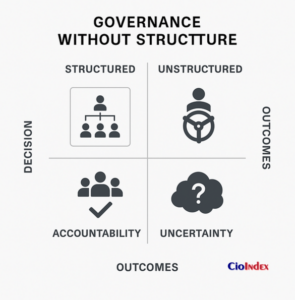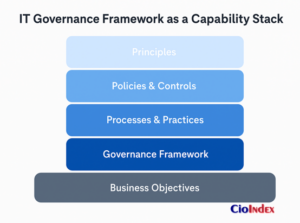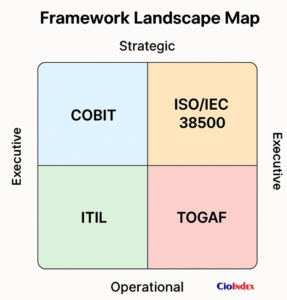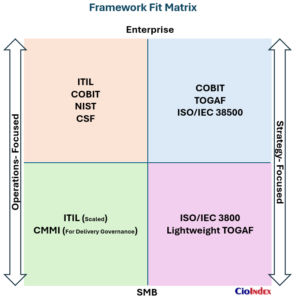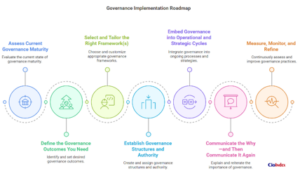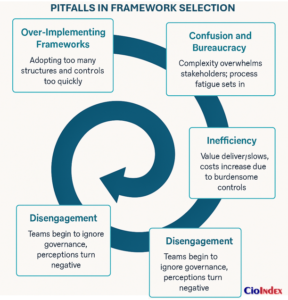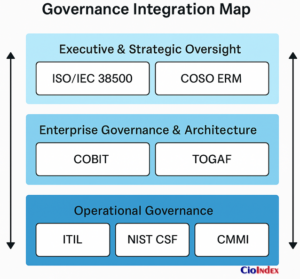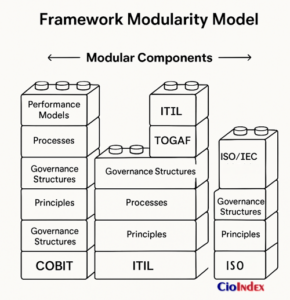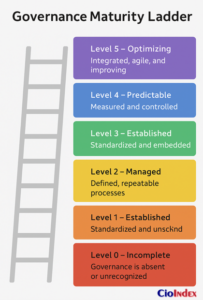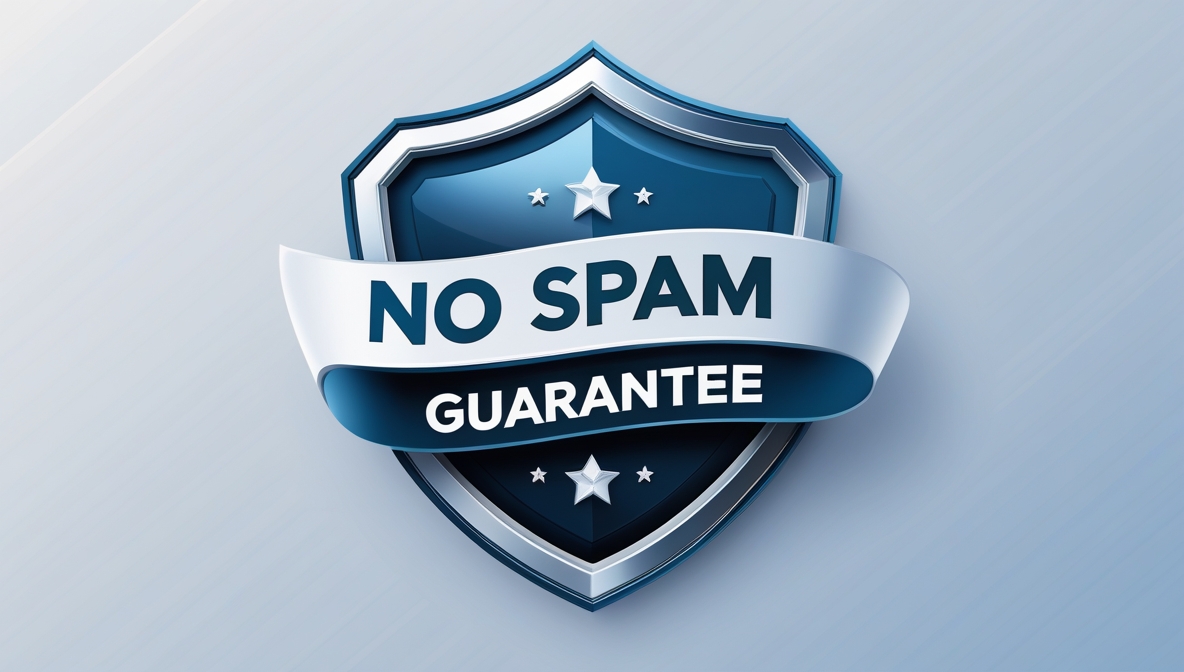Strategy without structure is storytelling. And in technology, structure begins with governance frameworks.
Not the kind that sits untouched in policy binders or tick boxes on an audit checklist—but living, working models that turn strategic intent into operational clarity. Because without that scaffolding, even the best IT governance plans collapse under the weight of ambiguity. Who makes decisions? How are risks evaluated? Which investments align with business goals? These aren’t questions for ad hoc committees or hallway conversations. They require discipline. And discipline needs a framework.
Unfortunately, “framework” is one of the most abused words in the IT lexicon. It’s invoked to sound rigorous, cited to signal compliance, or implemented wholesale with the hope that structure alone will save the day. But real governance isn’t one-size-fits-all. And frameworks aren’t plug-and-play.
This article cuts through the noise. It examines the major IT governance frameworks—COBIT, ISO/IEC 38500, ITIL, TOGAF, and others—not just as static models, but as decision-support systems. It shows when to use them, how they differ, where they complement each other, and why the best governance leaders treat them not as dogma, but as design tools.
Because in organizations where IT is inseparable from business strategy, governance isn’t optional. It’s infrastructure.
Looking for practical implementation tools, maturity models, or integration roadmaps? Explore our in-depth IT Governance Library available exclusively to members
What is an IT Governance Framework?
A governance framework is not a manual, a methodology, or a checklist. It’s a structure — a set of guiding principles, decision models, and accountability mechanisms designed to ensure that IT serves the business, not the other way around.
At its core, an IT governance framework defines how an organization makes decisions about technology:
- Who has the authority to approve investments?
- How are priorities set, and resources allocated?
- What processes exist to evaluate risk, ensure compliance, or measure outcomes?
But more than just assigning roles or mapping workflows, a framework creates consistency at scale. It transforms governance from a personality-driven process (based on who’s in the room) to a system-driven discipline (based on pre-agreed rules, roles, and criteria). It turns scattered policies into a coordinated model for control, performance, and alignment.
And this is where confusion often begins.
Many assume a framework must be adopted in full—implemented wholesale as a fixed system. Others treat frameworks as theoretical overlays, disconnected from the operational grind of delivery. Both approaches miss the point.
A well-used framework is not prescriptive. It is adaptive. It provides structure without strangling autonomy. It enables oversight without micromanagement. It aligns execution with strategy—whether that strategy is cost control, innovation, compliance, or growth.
In practical terms, IT governance frameworks are used to:
- Standardize decision-making across business units, geographies, or functions
- Align IT services and investments with enterprise goals
- Embed accountability across leadership and delivery teams
- Mitigate risk and ensure compliance with industry regulations
- Track performance and value realization in measurable terms
Think of them as modular: each framework offers a different angle on governance—some focus on high-level principles, others on operational mechanics. Some prioritize business alignment, others risk, service delivery, or architecture. And while no single framework fits every organization, understanding what each one offers—and where they overlap—is essential for building a governance model that actually works.
The next section will break down the most widely used frameworks—COBIT, ISO/IEC 38500, ITIL, TOGAF, and others—so you can see what they are, how they’re used, and which governance challenges they were built to solve.
Pro Tip: Don’t ask which framework is “the best.” Ask which problems you need to solve—and then select the framework, or combination of frameworks, that addresses them best.
Overview of the Major Frameworks
There is no shortage of frameworks in the IT governance ecosystem—each born from different priorities, serving different audiences, and evolving over time. But while the alphabet soup can be intimidating, most modern governance models converge around a shared goal: ensuring technology delivers value while managing risk.
What distinguishes them is their point of entry: strategic vs. operational, principle-based vs. process-based, broad vs. domain-specific.
Below is a breakdown of the most widely used IT governance frameworks—each with a distinct governance lens and value proposition. Together, they form the toolkit from which modern governance models are built.
At a Glance: Framework Comparison Table
| Framework | Primary Focus | Scope | Best Used For | Primary Audience |
| COBIT | Enterprise IT governance | Strategic + tactical | Aligning IT with business strategy and risk | CIOs, Risk Officers, Auditors |
| ISO/IEC 38500 | Corporate-level IT oversight | Executive + board level | Policy and accountability at the highest levels | Boards, Executives |
| ITIL | IT service delivery and management | Operational | Standardizing IT service performance | IT Ops, Service Managers |
| TOGAF | Enterprise architecture governance | Strategic + architectural | Business-aligned IT architecture design | Enterprise Architects, CIOs |
| NIST CSF | Cybersecurity governance | Risk and security | Managing cyber risk and security controls | CISOs, Compliance Teams |
| CMMI | Capability maturity & process quality | Process performance | Improving delivery performance and governance | PMOs, QA Leaders |
COBIT (Control Objectives for Information and Related Technologies)
Few frameworks are as synonymous with enterprise IT governance as COBIT. Originally developed by ISACA in the 1990s as a tool for IT auditors, COBIT has since evolved into a comprehensive framework for governing and managing enterprise information and technology, used by governments, banks, and multinational corporations alike.
Governance Philosophy
COBIT distinguishes sharply between governance (evaluate, direct, monitor) and management (plan, build, run, monitor) — a crucial line for organizations seeking clear accountability. It positions governance as a board-level function that determines objectives, while management executes against those objectives under oversight.
Key Components
- Governance System and Components: Enablers such as principles, processes, structures, culture, and information.
- Goals Cascade: A structured method to translate enterprise goals into IT-related goals, which then inform specific enablers and metrics.
- Performance Management: Maturity and capability models allow organizations to assess their current governance effectiveness and chart improvement paths.
Use Cases
- Designing or refining a governance operating model
- Implementing controls across multiple IT domains
- Aligning IT initiatives to business strategy at scale
- Auditing IT performance and governance maturity
Best Fit
COBIT is ideal for organizations with enterprise-level governance ambitions — those that need a consistent model across multiple business units, risk domains, or regulatory boundaries. It’s particularly well-suited for industries where transparency, accountability, and formal oversight are non-negotiable, such as financial services, healthcare, and public sector entities.
ISO/IEC 38500
Where COBIT offers structure and control, ISO/IEC 38500 offers principles and posture. As the international standard for the corporate governance of IT, this framework elevates IT governance into the boardroom — positioning it alongside financial, legal, and operational oversight.
Governance Philosophy
ISO/IEC 38500 is a principle-based model designed for boards and executives. It avoids operational detail in favor of high-level guidance that encourages leadership to treat IT as a strategic asset requiring the same diligence as capital, labor, and operations.
Six Guiding Principles
- Responsibility – Clear definition of roles and responsibilities for IT decisions
- Strategy – IT must support the organization’s current and future strategy
- Acquisition – IT investments should be justified and made for valid reasons
- Performance – IT should deliver measurable value
- Conformance – IT must comply with all policies, laws, and regulations
- Human Behavior – Consider the human factors in IT decisions and use
Use Cases
- Establishing board-level awareness of IT governance
- Integrating IT governance with corporate governance
- Creating policy-level accountability frameworks
- Educating non-technical stakeholders on governance responsibilities
Best Fit
ISO/IEC 38500 is best suited for executive and board audiences, especially in organizations seeking to unify IT governance with enterprise governance. It offers a strategic lens for organizations experiencing digital transformation, M&A activity, or pressure to modernize governance across C-suite.
ITIL (Information Technology Infrastructure Library)
Unlike COBIT and ISO/IEC 38500, ITIL operates not in the boardroom but on the ground—where services are delivered, tickets are resolved, and systems are maintained. But don’t mistake it for a tactical tool: ITIL is a governance framework for service value, ensuring that every service the IT function delivers contributes to business goals.
Governance Philosophy
ITIL defines governance as an integral part of the Service Value System (SVS). Governance provides oversight of strategy and policies, ensures continual alignment, and drives accountability throughout the service lifecycle.
Key Features
- Service Value Chain: A flexible operating model for the creation, delivery, and continual improvement of services.
- 34 Practices: Replacing the older concept of “processes,” ITIL 4’s practices support adaptability and modular implementation.
- Governance Integrated into SVS: Encourages organizations to embed governance in every aspect of service design and delivery—not bolt it on after the fact.
Use Cases
- Standardizing service delivery in complex IT environments
- Aligning IT operations with business demand
- Embedding continual improvement into governance routines
- Supporting DevOps, Agile, and hybrid delivery models
Best Fit
ITIL is the framework of choice for organizations that see IT as a service provider and need to manage demand, performance, and improvement systematically. It’s particularly effective in large enterprises, managed services environments, and regulated industries where reliable service delivery is tied directly to business performance and risk posture.
TOGAF (The Open Group Architecture Framework)
Every digital strategy is implemented through architecture—systems, processes, platforms, and data structures. TOGAF provides the governance to make sure that architecture is intentional, aligned, and sustainable.
Governance Philosophy
TOGAF promotes architecture governance as a formal capability embedded in the enterprise. It ensures that architectural decisions are made strategically, documented transparently, and enforced consistently—particularly across large, federated IT environments.
Key Components
- Architecture Development Method (ADM): A detailed method for developing and maintaining enterprise architecture.
- Content Framework: Defines the artifacts, deliverables, and relationships within architecture governance.
- Governance Bodies and Processes: Encourages establishment of Architecture Review Boards (ARBs), design authorities, and decision protocols.
Use Cases
- Governing large-scale digital transformations
- Aligning IT systems with business capabilities
- Rationalizing technology portfolios across divisions
- Integrating IT governance with business planning cycles
Best Fit
TOGAF is best suited for organizations with mature or maturing enterprise architecture practices, particularly those managing legacy modernization, ERP landscapes, or cloud migration at scale. It offers the scaffolding to ensure that architecture evolves with the business—not around it.
Additional Models That Support IT Governance
NIST Cybersecurity Framework (CSF)
- Focuses on cybersecurity risk governance.
- Complements other frameworks by adding depth to the risk and protection layers.
- Widely used in critical infrastructure sectors and by government contractors.
CMMI (Capability Maturity Model Integration)
- Offers a structured approach to process improvement and delivery governance.
- Useful in PMOs, software development, and high-assurance delivery environments.
COSO ERM (Enterprise Risk Management)
- Focuses on broader enterprise risk oversight.
- Often used alongside COBIT to integrate IT risk into the overall risk management strategy.
Pro Tip: Frameworks don’t govern your organization—you do. Use them not to standardize for the sake of compliance, but to build the clarity, control, and cohesion that modern digital enterprises demand.
To explore how these frameworks come to life in practice—from planning to operational execution—read our full implementation guide: Implementing IT Governance: From Strategic Planning to Operational Execution.
Choosing the Right Framework for Your Organization
If governance is a matter of structure, then selecting a framework is an exercise in architectural intent. And like any good architecture, the framework you choose should reflect not only what you’re building—but also what you’re trying to avoid collapsing.
Yet this is where many organizations stumble. They select a framework because it’s popular in their industry, aligns with an audit checklist, or promises compliance in a box. Others layer multiple models on top of one another without coordination, creating a governance environment that’s more bureaucratic than beneficial.
The goal is not to adopt a framework. The goal is to solve problems. To reduce ambiguity. To embed accountability. To drive alignment between business strategy and technology execution. The framework you choose is simply the vehicle.
Framework Fit Begins with Strategic Priorities
Different frameworks emphasize different dimensions of governance. Some focus on board-level policy and leadership accountability. Others are designed for operational control, architecture rationalization, or service performance. The right framework—or combination—depends on the governance challenges you’re solving:
| Governance Priority | Recommended Framework(s) |
| Strategic alignment of IT and business | COBIT, ISO/IEC 38500 |
| Enterprise-wide governance architecture | COBIT, TOGAF |
| IT service performance and operations | ITIL |
| Digital transformation and architecture | TOGAF, COBIT |
| Board-level oversight and policy clarity | ISO/IEC 38500 |
| Cybersecurity risk and resilience | NIST CSF + COBIT |
| Maturity assessment and improvement | COBIT, CMMI |
A forthcoming visual Framework Fit Matrix will help map these combinations more intuitively based on organization size, risk profile, and delivery model.
Start with Your Context, Not the Framework
Before you reach for COBIT or ITIL, step back and interrogate your own environment:
- What are the key governance problems you’re trying to solve?
- How mature is your organization’s IT decision-making process?
- What is your industry’s regulatory burden or audit landscape?
- Is your business centralized or federated in structure?
- Are you delivering IT via projects, products, or services?
- Who needs to be governed—and who does the governing?
These questions shape framework selection far more than vendor recommendations or Gartner grids.
Combining Frameworks: A Layered Approach
In practice, most effective IT governance models are hybrid. They layer complementary frameworks to create a cohesive system. For example:
- COBIT for strategic direction + ITIL for operational execution
- ISO/IEC 38500 to engage the board + TOGAF to guide architecture governance
- COBIT + NIST CSF for aligning enterprise governance with cybersecurity oversight
This layered approach avoids overreliance on a single philosophy and creates modular governance that can evolve with your organization.
A framework isn’t a finish line. It’s a foundation. What you build on top—structure, committees, performance systems, accountability models—is what creates real impact.
Framework Selection Traps to Avoid
Even with clarity of purpose, many organizations fall into common traps:
- Framework as checkbox: Treating it as a compliance requirement rather than a design tool
- Over Implementation: Applying all components, even those irrelevant to the organization’s size or complexity
- Misalignment with culture: Choosing frameworks that clash with decision-making norms or organizational agility
- Too many frameworks, no integration: Creating silos of governance across risk, delivery, architecture, and service
Each of these traps turns a powerful enabler into an administrative burden. Selection is just the beginning. Adaptation, integration, and communication determine whether the framework enables clarity—or compounds confusion.
Pro Tip: A framework can’t govern your enterprise—it can only support your ability to govern well. Choose the structure that best fits your challenges, scale it wisely, and tailor it relentlessly.
Purpose of the Matrix
This 2D chart is designed to help IT leaders identify the most appropriate IT governance frameworks based on two key organizational dimensions:
- Delivery Model (horizontal axis): ranging from Operations-Focused to Strategy-Focused
- Organizational Size & Complexity (vertical axis): ranging from Small/Medium Business (SMB) to Enterprise/Highly Regulated
This structure helps decision-makers visualize framework fit across contexts—whether you’re a lean, service-focused IT team or a multi-division enterprise managing enterprise risk, architectural complexity, or compliance burdens.
How to Read the Matrix
Each quadrant groups frameworks that are best suited for the needs and characteristics of organizations in that zone:
Top Right: Enterprise + Strategy-Focused
- Frameworks: COBIT, TOGAF, ISO/IEC 38500
- Best For: Large organizations with complex governance requirements, digital transformation agendas, and the need for executive-level accountability and architectural alignment.
Top Left: Enterprise + Operations-Focused
- Frameworks: ITIL, COBIT, NIST CSF
- Best For: Large or regulated IT service environments where operational control, reliability, and cybersecurity are critical.
Bottom Right: SMB + Strategy-Focused
- Frameworks: ISO/IEC 38500, Lightweight TOGAF
- Best For: Smaller organizations pursuing strategic alignment, often in transformation mode or seeking board-level engagement without excessive overhead.
Bottom Left: SMB + Operations-Focused
- Frameworks: ITIL (scaled), CMMI (for delivery governance)
- Best For: Smaller IT functions needing service consistency and delivery governance without over-engineering.
This matrix is a diagnostic visual, not a rulebook. It’s meant to help CIOs and IT governance leads ask:
“Given our scale and priorities, which framework(s) best support the kind of governance we need to build?”
You can also use it to:
- Justify framework decisions to executive stakeholders
- Identify gaps in your governance model (e.g., overemphasis on operations without strategy)
- Tailor adoption strategies by quadrant (lighter, modular implementation for SMBs vs. layered integration for enterprises)
Steps to Implement an IT Governance Framework
No framework delivers value at adoption. The real value comes from adaptation—the deliberate integration of a framework into your organization’s structure, strategy, and culture. And while the steps below are presented sequentially, the implementation of IT governance is rarely linear. It’s recursive, iterative, and political. You’re not installing software—you’re reshaping how decisions are made.
This section outlines the strategic stages of implementation—designed not as a rigid checklist, but as a map CIOs and governance leaders can use to guide transformation.
Step 1: Assess Current Governance Maturity
Governance doesn’t begin with the framework. It begins with a mirror.
Before selecting or implementing anything, assess your current governance posture:
- Are decision-making rights clearly defined?
- Is IT strategy visibly linked to business outcomes?
- How is accountability distributed across business and technology units?
- Are risk, value, and performance systematically tracked?
Use tools like the COBIT Design and Implementation Model, the COBIT Performance Management maturity assessment, or your own enterprise governance maturity framework. What matters is not how you score, but what you surface—ambiguity, inconsistency, and structural gaps.
Tip: Frame the assessment in business terms. Senior leadership will respond more readily to risks of misalignment, duplication, or underperformance than to abstract references to maturity models.
Step 2: Define the Governance Outcomes You Need
Before choosing a framework, define what you’re trying to achieve. Examples:
- Clarity in project prioritization and funding?
- Risk visibility across IT and business?
- Executive-level IT accountability?
- Performance transparency and value realization?
- Architecture discipline and system rationalization?
Tip: Be ruthless in narrowing your focus. Governance that tries to do everything at once does nothing well.
Step 3: Select and Tailor the Right Framework(s)
Based on your assessment and objectives, use your Framework Fit Matrix to identify the best-aligned framework(s). Then tailor them. Even COBIT’s own documentation insists: “Design for context.”
Tailoring may include:
- Scaling processes to fit organizational complexity
- Reframing terminology to match internal language
- Merging or trimming components to avoid duplication
Tip: Avoid “lift-and-shift” implementations—especially from case studies or peer organizations. Your governance should be as unique as your business model.
Step 4: Establish Governance Structures and Authority
Now build the scaffolding:
- Define governance bodies (e.g., IT Steering Committee, Architecture Review Board)
- Assign decision rights and escalation paths
- Draft or update charters and mandates
- Integrate governance checkpoints into existing business rhythms (e.g., strategy cycles, investment boards, program reviews)
Tip: Structure is what prevents governance from devolving into personality-driven politics. If roles are unclear, decisions default to whoever speaks last—or loudest.
Step 5: Embed Governance into Operational and Strategic Cycles
Governance doesn’t live on its own island. It must be embedded in:
- Strategic planning and budgeting
- Portfolio and program management
- Risk and compliance monitoring
- Service delivery and operational performance
Tip: This is where frameworks often fail—not because they’re wrong, but because they’re bolted on after the fact. Real governance is not a department. It’s a design principle.
Step 6: Communicate the Why—and Then Communicate It Again
Even the best-designed frameworks fail without stakeholder buy-in. Implementation isn’t just structural—it’s cultural.
- Position governance as strategic enablement, not bureaucratic control
- Identify governance champions in each business unit
- Align communications with business value: faster decision-making, less risk exposure, better performance insight
Tip: Communicate early, frequently, and through multiple channels—governance fails in silence.
Step 7: Measure, Monitor, and Refine
Governance is not an install—it’s a capability. Like any capability, it matures over time, and must be tuned as the organization evolves.
- Define KPIs for governance effectiveness (value realization, cycle time, risk mitigation, compliance health)
- Use frameworks with built-in performance models (e.g., COBIT’s performance metrics)
- Regularly revisit and refine decision structures, roles, and metrics
Tip: Governance that doesn’t evolve becomes irrelevant. Build a culture of continual improvement—and make space for feedback loops.
Pro Tip: Don’t implement a framework—build a governance capability. The former is a project; the latter is a permanent source of strategic advantage.
Common Pitfalls in Framework Adoption
Frameworks promise clarity, accountability, and alignment—but in many organizations, they deliver the opposite. Not because the frameworks are flawed, but because their implementation is. Misapplied frameworks can multiply complexity, calcify bureaucracy, and undermine trust in the governance effort itself.
Avoiding these failures starts with knowing where they originate.
Framework as Compliance Theater
Too often, frameworks are adopted for appearances, not outcomes. Governance becomes a box-ticking exercise—focused on audits, documentation, and formalities that create the illusion of control without the substance of it.
- ITIL becomes a service catalog no one uses.
- COBIT becomes a set of charts no one interprets.
- ISO 38500 becomes a PowerPoint for board meetings, never revisited.
Symptoms:
- Misalignment between governance outputs and business decisions
- Little to no behavior change among decision-makers
- Metrics reported but never acted on
Solution:
Treat governance as a business capability, not a compliance obligation. Design metrics, policies, and decision structures that enable performance—not just satisfy external scrutiny.
Overengineering the Framework
In an effort to “do it right,” many teams over-implement frameworks—adopting every component, every process, every flowchart—regardless of whether it fits the organization’s size, culture, or current maturity.
- SMBs roll out full-scale COBIT models built for multinationals
- Service teams implement 34 ITIL practices when 6 would suffice
- ARBs are mandated in orgs with no architectural discipline
Symptoms:
- Process fatigue
- Decision bottlenecks
- Stakeholder disengagement
Solution:
Start with need, not completeness. Tailor the framework to solve the specific governance challenges you face. Scale incrementally. The best governance models grow with the organization, not ahead of it.
Governance Pitfalls Table
| Pitfall | Symptom | Corrective Action |
| Framework as Compliance Theater | Policies and metrics exist but are unused or irrelevant | Design governance for business outcomes, not audits. Align decisions to strategy. |
| Overengineering the Framework | Decision fatigue, low adoption, unnecessary complexity | Start with core needs. Implement only what adds immediate value. Scale gradually. |
| Cultural Misalignment | Stakeholders bypass processes or disengage from governance activities | Tailor language and roles to the organization’s decision culture. Co-create where possible. |
| Siloed Framework Implementation | Redundant structures, conflicting mandates, disconnected practices | Build a governance integration map. Align frameworks and clarify decision flow. |
| Lack of Executive Sponsorship | Governance bodies lack authority, decisions made informally | Secure C-level ownership. Embed governance in enterprise decision-making cycles. |
| No Feedback or Iteration | Governance model grows stale, policies don’t evolve with strategy or scale | Establish feedback loops and review cycles. Treat governance as a living system. |
Misalignment with Organizational Culture
A governance framework may be structurally sound but culturally incompatible. An engineering-led organization may reject bureaucratic layers. A consensus-driven firm may resist strict escalation paths. A startup culture may find governance constraining unless positioned as an enabler.
Symptoms:
- Passive resistance to governance roles or policies
- Informal workarounds to formal approval processes
- Governance processes bypassed in practice
Solution:
Fit the governance model to the decision culture, not just the org chart. Engage stakeholders in co-design. Make governance intuitive and contextual—not imposed.
Siloed Framework Implementation
Many organizations implement frameworks within functional silos: IT adopts ITIL, architecture teams follow TOGAF, security works with NIST CSF—but none of them talk to each other.
- Governance of service delivery is divorced from governance of architecture
- Strategic risk management doesn’t inform program execution
- Portfolio boards and ARBs operate in isolation
Symptoms:
- Redundant governance bodies
- Conflicting mandates or decision criteria
- Fragmented reporting and accountability
Solution:
Build a governance integration map. Clarify where frameworks intersect and overlap. Align decision-making rights and escalation paths across all governance layers. Create a single source of governance truth.
No Executive Sponsorship
Frameworks cannot fix governance if the leadership won’t. Without sustained executive attention, frameworks degrade into background noise—implemented in theory, ignored in practice.
Symptoms:
- Governance structures lack authority
- Decisions continue to be made informally
- Initiatives stall due to unresolved escalations
Solution:
Anchor governance at the top. Board and C-suite participation isn’t optional — it’s structural. Use frameworks like ISO/IEC 38500 to engage leadership early and define their role in setting governance tone and direction.
No Feedback, No Evolution
Governance must evolve alongside the business. Yet many frameworks are implemented once and then left untouched—even as strategy, structure, and scale shift dramatically.
Symptoms:
- Framework no longer reflects how the business operates
- Governance metrics go stale
- Stakeholder frustration with outdated policies
Solution:
Make governance a living system. Establish feedback loops. Revisit charters, roles, and metrics annually. Treat framework evolution as part of your continuous improvement capability.
Pro Tip: A good framework, misapplied, becomes a bad governance experience. The key isn’t in how much you adopt—but in how precisely you tailor, communicate, and integrate governance into the real life of the enterprise.
Adapting and Tailoring Frameworks
No framework, however comprehensive, was designed for your organization. Not your decision culture. Not your architecture complexity. Not your regulatory profile, appetite for innovation, or operational bottlenecks.
That’s why the most important governance decision isn’t which framework you choose—it’s how you tailor it.
Frameworks are scaffolding, not systems. Their power lies in their ability to be adapted, blended, scaled, and reinterpreted in ways that reflect the shape, speed, and sensitivity of your enterprise. The worst implementations treat frameworks as gospel. The best treat them as blueprints—with room for architecture.
Design for Context, Not Compliance
Most frameworks offer guidance, not mandates. COBIT, for example, encourages organizations to design a governance system based on enterprise goals, risk appetite, and operating model. ITIL provides modular practices that can be selectively adopted. TOGAF allows customization of its ADM to suit architecture maturity.
Use that flexibility. Start by asking:
- What decision-making friction are we trying to reduce?
- Which accountability is unclear or misaligned?
- Where is governance duplicated or missing entirely?
Only then map framework components to those needs. Governance isn’t installed—it’s designed.
Modularize the Framework
Break frameworks into building blocks:
- In COBIT: Principles, enablers, and management objectives
- In ITIL: Practices (formerly “processes”), governance as part of the service value system
- In TOGAF: Phases of the ADM cycle, governance checkpoints, architecture boards
This allows you to:
- Start small, with targeted governance areas (e.g., project intake, change enablement)
- Test frameworks in a specific domain before scaling (e.g., apply COBIT to infrastructure, then extend to applications)
- Introduce only what your teams can absorb
Frameworks are more effective when implemented as capability increments, not mandates.
Adjust Language and Layering
Governance fails when it feels foreign. Translating frameworks into your organization’s language and hierarchy ensures relevance.
- Re-label roles and artifacts to match internal terminology
- Align framework decision rights with your actual leadership structure
- Layer framework activities into existing rhythms — strategic planning, budgeting, release trains, architecture reviews
Don’t build parallel systems. Embed governance where it already makes sense.
Blend Frameworks Intentionally
Most mature organizations don’t implement one framework — they implement several, and often without realizing it. The key is to blend them deliberately, not by default.
For example:
- Use ISO/IEC 38500 to define board-level governance principles
- Apply COBIT to establish enterprise-wide IT governance mechanisms
- Leverage ITIL for day-to-day service management practices
- Integrate TOGAF for architecture decision-making and capability alignment
- Layer in NIST CSF or COSO for security and risk oversight
Tip: Create a governance integration map showing which framework governs what—and how decision flow, reporting, and accountability connect across them.
Iterate and Evolve the Fit
Tailoring is not a one-time activity—it’s a continuous calibration process. As business models shift, technologies evolve, and leadership changes, so must governance.
Build governance feedback loops:
- Review governance effectiveness quarterly or semi-annually
- Reassess framework fit during strategy or planning cycles
- Solicit stakeholder feedback after key governance touchpoints (e.g., steering committee meetings)
Make refinement a governance ritual.
Pro Tip: The best governance frameworks don’t come from a book. They come from context. Tailor with intent. Start where the friction is. Build what fits—and evolve it as you grow.
Measuring Governance Effectiveness
Governance without measurement is governance by assumption.
And in too many organizations, that assumption is dangerously optimistic. Decision structures exist, committees meet, policies are written—but few can say with confidence whether their IT governance model is delivering real strategic value, reducing risk, or improving outcomes.
Effective IT governance is not just implemented — it’s audited, tested, and tuned. Measurement is the mechanism that turns governance from static structure into a living system of accountability and improvement.
This section explores what to measure, how to interpret results, and how to use those insights to mature your governance capability over time.
Why Measurement Matters
Without metrics, governance becomes:
- Invisible to executives and boards
- Unaccountable to those it governs
- Vulnerable to erosion as organizational priorities shift
Measurement gives governance:
- Legitimacy in the eyes of leadership and business units
- Direction for continuous improvement
- Defensibility during audits, crises, or investment reviews
In short, measurement keeps governance real.
What to Measure: Three Dimensions of Governance Performance
Governance measurement is not just about tracking policies or process adherence. It should reflect the strategic outcomes governance exists to enable.
- Strategic Alignment
- % of IT initiatives with documented links to business goals
- Value realization metrics (e.g., post-implementation benefit capture)
- Executive satisfaction with IT’s contribution to business strategy
- Use of frameworks like COBIT’s Goals Cascade or strategy scorecards
- Risk and Compliance Oversight
- Number and severity of policy/risk exceptions
- Incident or audit findings related to governance lapses
- Percentage of IT risks tracked and mitigated through governance processes
- Time-to-remediate for governance-related compliance gaps
- Decision-Making and Accountability
- Time-to-decision for key IT investments
- Escalation resolution cycle time
- Participation rates in governance bodies (steering committees, ARBs)
- Stakeholder satisfaction with governance processes (qualitative metrics)
Tip: Combine quantitative KPIs with qualitative signals — feedback, clarity of roles, decision friction—to get a complete picture.
Strategic Alignment / Risk Oversight / Accountability KPIs
| Governance Dimension | Key Performance Indicators (KPIs) | Purpose |
| Strategic Alignment | – % of IT initiatives aligned to documented business goals
– Value realization rate (forecasted vs. actual business benefits delivered) – % of IT spend tied to strategic programs or OKRs – Stakeholder satisfaction with IT strategy execution |
– Measures how well IT projects reflect strategic intent
– Validates ROI and benefit tracking processes – Indicates financial alignment between IT and enterprise priorities – Captures perception-based indicators of alignment quality |
| Risk Oversight | – Number of policy exceptions or ungoverned initiatives
– % of identified IT risks addressed through governance structures – Compliance health score (e.g., % controls tested and passed) – Incident escalation time vs. target response window |
– Flags breakdowns in governance enforcement
– Measures governance’s role in mitigation planning – Gauges audit readiness and control maturity – Tests governance under pressure—response mechanisms and escalation clarity |
| Accountability & Decision Quality | – Time-to-decision for key governance forums (e.g., architecture board, steering committee)
– % of projects with defined owners and decision paths – Number of governance escalations resolved without delay — Participation rates in governance bodies (e.g., attendance, voting quorum, documentation) |
– Reflects efficiency of governance bodies
– Measures clarity of ownership and governance role structure – Tests effectiveness of dispute resolution and authority clarity – Captures commitment and formality of governance practice |
Governance Maturity Models
To contextualize metrics, use a maturity model to evaluate governance capability over time. COBIT’s Performance Management Model (CPM) is a widely recognized example, offering six maturity levels for governance components:
|
Level |
Definition |
| 0 | Incomplete – governance not applied |
| 1 | Performed – applied ad hoc, inconsistently |
| 2 | Managed – defined and repeatable |
| 3 | Established – standardized, embedded |
| 4 | Predictable – measured and proactively controlled |
| 5 | Optimizing – continuously improving |
Maturity assessments allow leaders to:
- Benchmark their current state
- Identify priority areas for investment
- Track progress as capabilities evolve
How to Use Metrics Wisely
Governance metrics should be:
- Actionable – tied to specific decisions or improvement areas
- Aligned – supporting business and IT objectives
- Balanced – not over-optimized for compliance at the expense of agility
Avoid vanity metrics (e.g., number of policies created). Focus instead on indicators of decision quality, clarity, and strategic contribution.
Dashboards and Governance Reporting
For governance to stay top-of-mind, it must be visible. Develop dashboards and reporting structures that:
- Surface real-time governance metrics to leadership
- Provide monthly/quarterly summaries to governance bodies
- Visualize alignment between projects, risks, and strategy
Example: A dashboard that shows which projects are approved, deferred, or escalated—mapped against strategic goals and funding status.
Make governance visible, or it becomes invisible by default.
Pro Tip: Governance doesn’t succeed because it exists — it succeeds because it performs. Measure what matters, make it visible, and use the data to drive better decisions at every level of the enterprise.
In Conclusion
Governance isn’t glamorous. It doesn’t make headlines when it works—but it always features in the postmortem when it doesn’t. Failed projects, unmet strategic goals, regulatory violations, cybersecurity incidents — these are symptoms of governance failure, not technical incompetence.
What this article has shown is that frameworks are not optional for serious governance — they are essential. But they are not the answer. They are the architecture within which better answers can be built.
COBIT gives you alignment. ISO/IEC 38500 gives you principles. ITIL gives you operational control. TOGAF gives you design governance. Together, they offer the scaffolding for a governance system that can scale with complexity, mature with strategy, and adapt as your enterprise evolves.
But they only work if you make them yours:
- Choose frameworks that match your priorities.
- Tailor them to your structure, culture, and maturity.
- Measure their effectiveness—not their presence.
- Evolve them continuously, not episodically.
Because governance isn’t a project. It’s infrastructure for decision-making — the system through which leadership is exercised, risk is managed, and value is realized in a digital enterprise.
If you’re ready to move from framework theory to governance capability, explore our exclusive to members IT Governance Playbook which breaks down governance into actionable steps making it easier for CIOs to develop tailored governance frameworks that drive organizational success while remaining flexible enough to adjust to specific needs.
